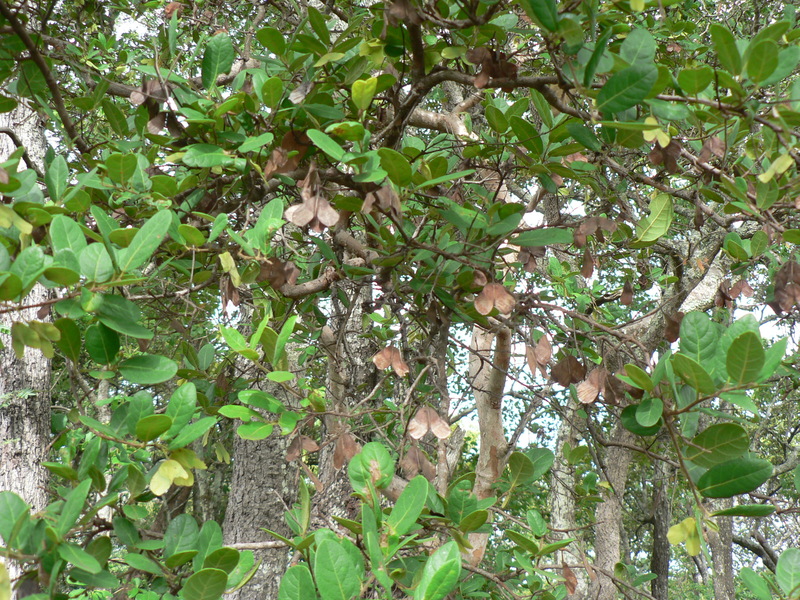Hymenocardia acida

|
|
Hymenocardia acida Common Names: Hymenocardia, Heart Fruit, Sour Plum Scientific
Classification Kingdom: Plantae Clade: Tracheophytes Clade: Angiosperms Clade: Eudicots Clade: Rosids Order: Malpighiales Family: Phyllanthaceae Genus: Hymenocardia Species: H. acida Synonyms: Hymenocardia acida var.
mollis (Pax)
Radcl.-Sm., Hymenocardia acida var. acida, Hymenocardia granulata Beille Morphological Description Hymenocardia acida is a deciduous shrub or small tree, typically growing 2–7 m
tall, occasionally reaching 10 m in favorable conditions. Its key morphological
features include: · Stem: Gnarled, twisted, with rough, rusty-red bark; bole up to 30
cm in diameter, exuding a milky sap when cut. · Leaves: Simple, alternate, ovate to elliptic, 5–15 cm long, 3–8 cm
wide, with serrated margins, acidic taste, green turning yellow before
shedding. · Flowers: Small, 2–5 mm long, greenish-yellow, unisexual (dioecious or
monoecious), borne in axillary or terminal panicles; male flowers with five
stamens, female with a tricarpellary ovary. · Fruit: Three-lobed capsules, 1–2 cm long, winged, green turning
brown, splitting to release flat, winged seeds. The plant’s distinctive
bark and winged fruits align with Phyllanthaceae traits (Radcliffe-Smith,
1996). Distribution and Habitat Hymenocardia acida is widespread across tropical Africa, recorded in: · West Africa: Senegal, Nigeria, Ghana, Mali (annual rainfall 600–1,500
mm). · East Africa: Sudan, Kenya, Tanzania. · Central/Southern Africa: Angola, Zambia, Mozambique, South Africa. It thrives in dry
woodlands, savannas, and termite mounds, preferring sandy or loamy soils (pH
5.0–6.5) from sea level to 1,200 m altitude (Burkill, 1994). Ethnopharmacology Hymenocardia acida is a vital medicinal plant in tropical Africa is widely
recognized in traditional medicine for its diverse therapeutic applications.
Various parts of the plant, including the leaves, stem bark, and roots, are
utilized to treat ailments such as hemorrhoids, chest pain, eye infections,
migraines, skin diseases, and tumors. Phytochemical analyses have revealed the
presence of compounds like alkaloids, terpenoids, glycosides, flavonoids, saponins,
and tannins, which contribute to its medicinal properties. Notably, the stem
bark extract has demonstrated significant anticancer activity, particularly
when delivered using nanotechnology-based methods(Adedokun et al 2022).
Additionally, the methanol bark extract exhibits promising antidiarrheal
properties, supporting its traditional use against diarrhea. These findings
underscore the potential of Hymenocardia acida as a valuable resource in the
development of therapeutic agents for various health conditions. · Antisickling: Leaf extracts treat sickle cell disease in Nigeria. Ibrahim
et al. (2007) showed ethanol extracts (1% w/v) reversed sickled RBCs by 70%,
linked to flavonoids and saponins. · Antidiarrheal: Bark decoctions manage dysentery in Senegal. Usman et al.
(2021) found methanolic bark extracts (600 mg/kg) reduced castor oil-induced
diarrhea in rats by 65%, due to tannins and alkaloids. · Antihypertensive: Root decoctions lower blood pressure in
Guinea. Nsuadi Manga et al. (2013) reported methanolic root extracts (100
mg/kg) relaxed rat aorta via NO-cGMP, reducing BP in SHR by 15%. · Analgesic: Root poultices ease toothache in Northern Nigeria. Olotu et
al. (2011) confirmed methanolic root extracts (200 mg/kg) reduced acetic
acid-induced writhing in mice by 50%. · Antimalarial: Leaf decoctions treat fever in Côte d’Ivoire.
Vonthron-Sénécheau et al. (2003) found extracts inhibited Plasmodium falciparum (IC₅₀ 10 μg/ml), attributed to cyclopeptide
alkaloids. Additional traditional
uses—e.g., for cough, trypanosomiasis, and skin infections—are supported by
phytochemicals like hymenocardine, triterpenoids, and phenolic compounds
(Tor-Anyiin et al., 2013). ⚠ Toxicity Profile: High doses of bark extracts (>1,000 mg/kg in
rats) caused sedation and tremors, likely due to alkaloids. Leaf sap may
irritate skin and eyes. Caution is advised in prolonged use (Usman et al.,
2021). Additional Uses · Dye: Bark yields a brownish-red dye for textiles and leather
tanning (Burkill, 1994). · Fodder: Young leaves and twigs feed cattle and edible caterpillars
in Zambia (Radcliffe-Smith, 1996). · Construction: Hard, termite-resistant wood used for tools, fuel, and
building in Ghana (Schmelzer, 2008). · Ecological: Controls erosion, provides shade, and attracts bees for
pollination (Burkill, 1994). · Culinary: Sour young fruits eaten by children; leaves used as a
vegetable in Nigeria (Schmelzer, 2008). References
External Links More Pictures |
|
| Compounds of Hymenocardia acida | |
| References |